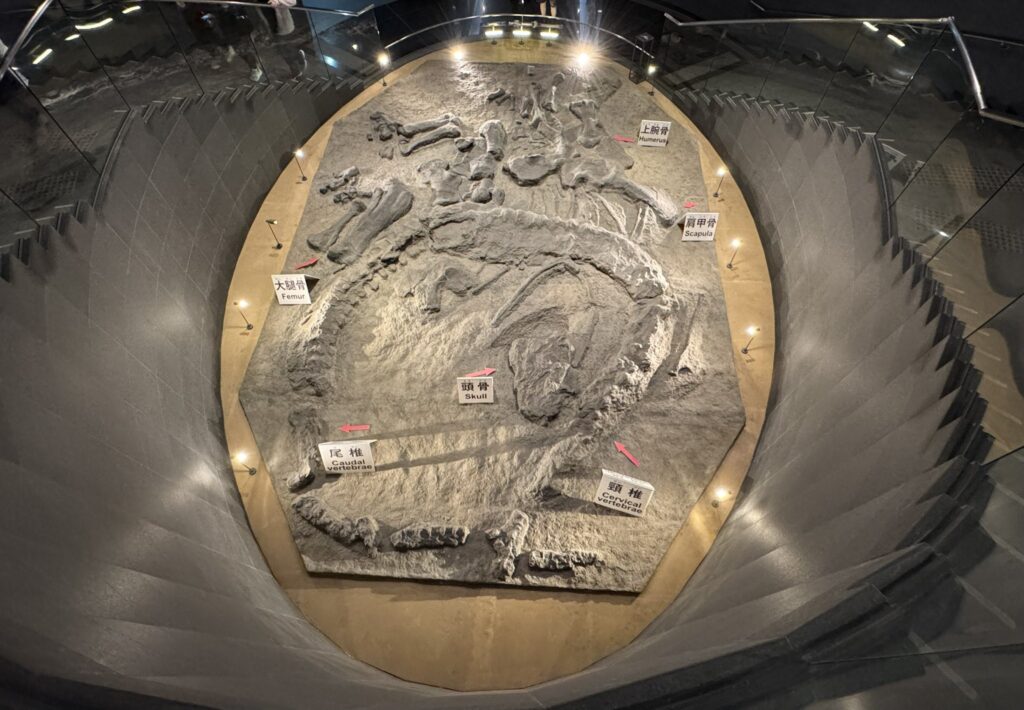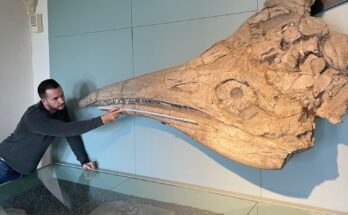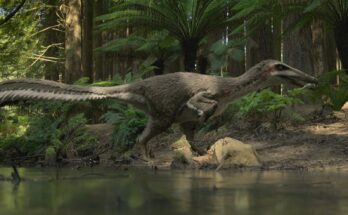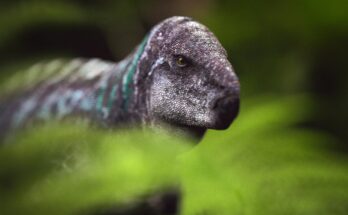Dinosaurs have long fascinated people across the world, but among the largest and most iconic are the sauropods — those long-necked, long-tailed plant eaters that dominated the Jurassic landscape. One of the most famous and best-studied sauropods is Camarasaurus, a name meaning “chambered lizard,” referring to the hollow, air-filled chambers in its vertebrae.
Living roughly 155 to 145 million years ago, Camarasaurus roamed the floodplains and forests of what is now North America. It was a huge, strong, yet relatively stocky dinosaur compared to some of its more slender cousins, such as Diplodocus or Brachiosaurus. In its day, Camarasaurus was one of the most common sauropods, leaving behind abundant fossil evidence that helps scientists understand its life and environment in surprising detail.
Camarasaurus was first described in 1877 by the famous paleontologist Edward Drinker Cope during the height of the Bone Wars, a period of fierce rivalry with fellow paleontologist Othniel Charles Marsh. The fossil bones Cope examined came from Colorado. These bones showed a curious structure in the vertebrae: large hollow spaces, or pleurocoels, that made the bones lighter. This is how Camarasaurus got its name — camara means “chamber” in Greek, and saurus means “lizard.”
In fact, Camarasaurus was one of the first sauropods to be found with a relatively complete skeleton, which was extremely important in reconstructing what these giant dinosaurs looked like. Before Camarasaurus, many sauropods were known only from a few scattered bones, and their shape was poorly understood.
Over the next decades, many more specimens were discovered in Wyoming, Utah, New Mexico, and Colorado, especially in the famous Morrison Formation, a rich fossil-bearing layer from the Late Jurassic. Thanks to these discoveries, Camarasaurus has become one of the best-understood sauropods in North America.
Physical Description
Camarasaurus was an impressive animal by any standard. On average, an adult Camarasaurus measured around 15–18 meters (50–60 feet) in length and weighed roughly 20–25 tons. Some species, like Camarasaurus supremus, were even larger, reaching nearly 23 meters (75 feet) long.
What made Camarasaurus distinctive compared to other sauropods was its relatively short, deep, box-shaped skull, with large openings (fenestrae) that reduced weight. Its teeth were robust and spoon-shaped, designed to strip or chomp tough, fibrous vegetation. Unlike the peg-like teeth of Diplodocus, Camarasaurus teeth were better adapted for cutting through coarser plant material.
Its neck was shorter and more muscular than the extremely long, whiplike neck of Diplodocus, giving Camarasaurus a somewhat more compact look. The vertebrae of its neck and back were strengthened with hollow air chambers, making the bones lighter without sacrificing strength — a brilliant evolutionary adaptation that helped support its huge size.
Camarasaurus had a long tail, though not as whip-like as some other sauropods. Its sturdy pillar-like legs ended in large feet, with a prominent thumb claw on each front foot, possibly used for defense or for handling food. Overall, Camarasaurus was built for power rather than extreme reach or speed, suggesting it browsed at medium heights rather than feeding from the tallest treetops.
Species of Camarasaurus
Paleontologists recognize several species of Camarasaurus, including:
- Camarasaurus grandis
- Camarasaurus lentus
- Camarasaurus lewisi
- Camarasaurus supremus
These species mainly differ in their size, proportions, and some features of their bones, but all share the general Camarasaurus body plan. They show how, over time, this genus spread across various regions and evolved subtle variations to adapt to different environments.

Diet and Feeding Behavior
Camarasaurus was a herbivore, feeding on ferns, conifers, cycads, ginkgoes, and other Jurassic plants. Its strong, spoon-shaped teeth were well suited for biting off tough branches, and its powerful jaws suggest it could handle harder plant material than many other sauropods.
Unlike long-necked sauropods that fed high up, Camarasaurus likely focused on mid-level vegetation, around 3–5 meters (10–16 feet) off the ground. Its flexible neck allowed it to reach up or down as needed, probably making it a generalist feeder, able to exploit many different kinds of plants.
Fossil evidence of Camarasaurus teeth shows considerable wear, suggesting it was a heavy eater that continually replaced its teeth throughout life. Like many sauropods, Camarasaurus swallowed plant material without much chewing, relying on enormous guts and possibly gastroliths (stomach stones) to help grind up the food.
Social Behavior
There is good evidence that Camarasaurus was social. Fossil finds have uncovered bonebeds where several Camarasaurus individuals died together, suggesting they lived in groups, perhaps family herds. Herding would have helped protect juveniles from predators like Allosaurus, the top predator of the Morrison Formation.
Young Camarasaurus grew fast, reaching nearly adult size in just a few decades, as shown by bone growth rings similar to tree rings. Fast growth, combined with living in herds, would have been an effective survival strategy against Jurassic predators.
Reproduction and Life Cycle
Like all sauropods, Camarasaurus laid eggs. Paleontologists have found fossilized sauropod eggs from the Jurassic, and although none can be definitively assigned to Camarasaurus, they likely laid similar eggs: relatively small compared to their giant body size (maybe 20–30 cm across), but laid in large numbers.
There is no evidence that Camarasaurus cared for its young after hatching. Most sauropods probably left the hatchlings to fend for themselves, relying on their rapid growth to escape predation. Baby Camarasaurus would have been vulnerable for their first few years but grew quickly thanks to an efficient metabolism.
Paleoenvironment: The Morrison Formation
Camarasaurus is one of the classic dinosaurs of the Morrison Formation, a famous fossil-rich rock layer that stretches across the western United States. During the Late Jurassic, this region was a warm, semi-arid floodplain, with wet and dry seasons, rivers, lakes, and open woodlands.
Camarasaurus shared its habitat with other famous dinosaurs, including:
- Allosaurus (predatory theropod)
- Stegosaurus (plated herbivore)
- Diplodocus (long-necked sauropod)
- Brachiosaurus (giraffe-like sauropod)
- Apatosaurus (heavy sauropod)
This rich ecosystem supported an incredible diversity of dinosaurs. Camarasaurus, being one of the most common sauropods, was a key player in this environment, shaping the ecosystem through its feeding habits.
Predators and Defense
Despite its size, Camarasaurus was not invincible. Fossils show bite marks from large theropods like Allosaurus, indicating they were preyed upon or at least scavenged after death.
Its best defense was its sheer size, and possibly herd living. Adults were likely too big to attack easily, but juveniles and sick individuals would have been tempting targets. The strong thumb claw might have been used as a defensive weapon, though that is still debated. Its heavy tail could also have served to lash out at attackers.
Fossil History and Paleontological Importance
Camarasaurus fossils are among the most complete of all sauropods. Because of this, Camarasaurus skeletons are displayed in museums all over the world, including:
- The American Museum of Natural History (New York)
- The Carnegie Museum of Natural History (Pittsburgh)
- The Smithsonian National Museum of Natural History (Washington, DC)
Paleontologists use Camarasaurus to help reconstruct how sauropods lived, grew, and moved. Its relatively complete skeleton has provided invaluable data for understanding sauropod anatomy, posture, and even possible locomotion patterns.
How Camarasaurus Moved
Sauropod locomotion is a fascinating area of study, and Camarasaurus helps paleontologists answer these questions. With its strong, pillar-like legs and broad feet, Camarasaurus was well adapted to support its gigantic weight. Its center of mass was more centered than in some sauropods, making it stable.
Trackways, or fossil footprints, show that sauropods like Camarasaurus generally walked at a slow, steady pace, perhaps 2–5 km/h (1–3 mph), in a coordinated “elephant-like” gait. These giant dinosaurs could migrate across their environment searching for food and water as needed, even though they were not built for speed.
Extinction and Legacy
Camarasaurus, like many of its Jurassic companions, eventually went extinct around 145 million years ago, as the Jurassic Period gave way to the Cretaceous. Changes in climate, ecosystems, and possibly competition with new kinds of plant-eaters may have contributed to its decline.
But Camarasaurus left behind a remarkable fossil legacy, one that continues to teach scientists about the incredible world of the Late Jurassic. Its name has become one of the most recognizable in dinosaur science, a reminder of how these long-extinct giants still shape our imagination today.


